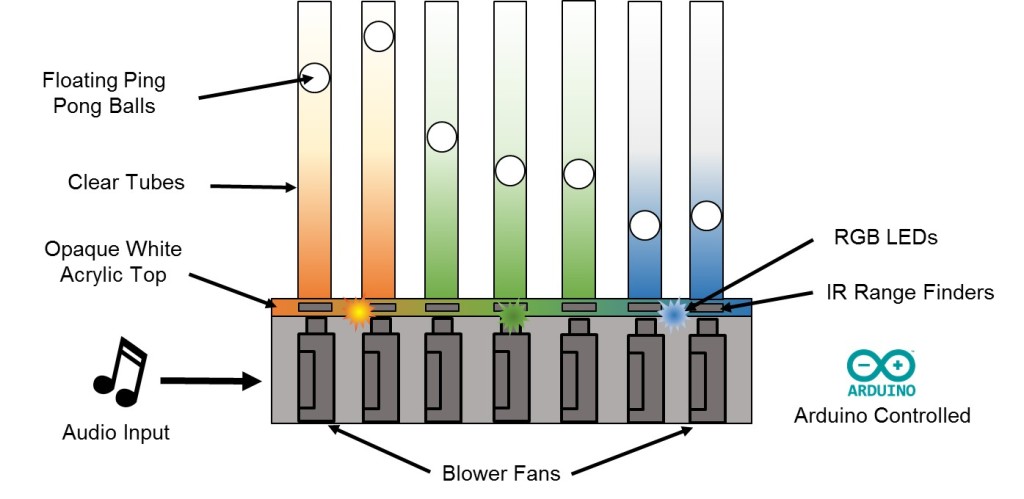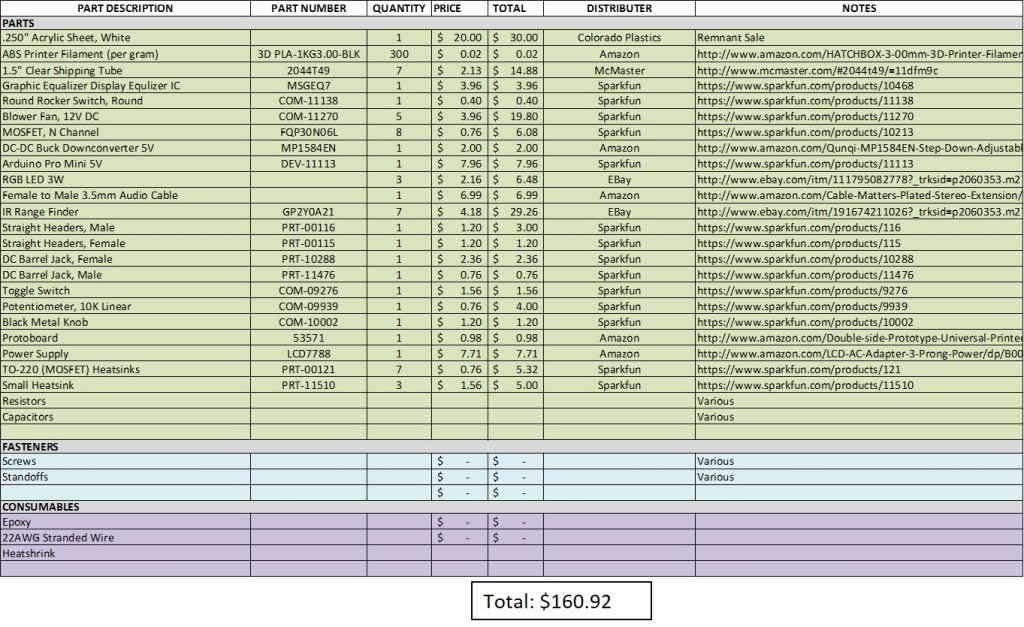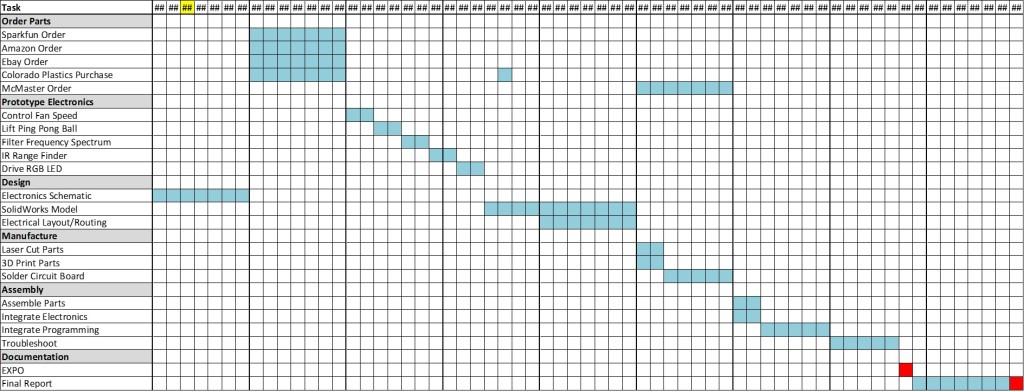Inspiration (from previous blog post):
For my final project, I want to create a dynamic sculptural-like device that allows a user to interact with music in a new way. My initial inspiration for this project came from the original implementation of frequency spectrum audio visualizers. These visualizers break the audio spectrum in to discrete chunks, and adjust bar levels which correspond to the amplitude of each range. They usually also include bright colors that correspond to bar height, or to distinguish the each range. The fancier implementations added an additional level of information by sustaining a bar at the highest peak (for each range) for an extended level of time, while the real time analysis would continue. This can be seen as the white lines in the below image.

Frequency Spectrum Audio Visualizer
I always envisioned that the colors bars where lifting up the white lines, where they would levitate for a second, before falling back down. As I started thinking about it, I realized that we have some innate fascination with objects that appear to defy gravity. If you have ever seen the rock sculptures that people build next to Boulder Creek in the summer, you will understand the intrigue of balance/levitation that I am attempting to describe. I want to try and capture this quality, and incorporate the the aesthetic in my project.

Crazy Gravity Defying Rock Sculpture
Concept:
To do this, I am currently toying with the idea of levitating a row of ping pong balls using fans. Just like the audio visualizer above, the ping pong ball heights would be dynamically adjusted to the changing frequency of input music. I am thinking that it will be possible to have a separate clear plastic tube for each ball, and then the fan speed could be adjusted to move the ball up and down the tube. I believe this will be the critical aspect of my project, and if it does not work, the project will not be feasible at all. My plan is to prototype a single tube/fan/ball setup in the coming week to determine if I should move forward with my idea. It may be possible to do it without a tube, similar to the classic hairdryer ping pong ball levitation experiment, but I am not sure that I would be able to control the rising and falling of the ball fast/accurate enough to implement an appealing visual experience.
My final project would likely include bright RGB LEDs to mimic the aesthetic of the original visualizers. I would like to hide the fans in a base below, but have a frosted acrylic top so the lights would nicely diffuse across the surface (and maybe light up the tube). I have also been thinking about ways to make the final product interesting without inputting music to be analyzed. It occurred to me that it could be cool to have an alternate “boot mode”, which would allow the user to conduct the height of each ping pong ball by raising/lowering their hand above an IR rangefinder mounted to the top plate.

First Impressions:
Upon first encountering this contraption, I want people to be intrigued and a little mystified. Listening to music is usually a purely auditory experience, so I think that this sort of physical/mechanical response is an interesting way to involve an additional sense. The lights are unnecessary to achieve this, but I am hoping that there bright saturated colors will draw the attention of people walking by. To further the involvement of this sense, it could be amusing to input audio of a specific frequency from an iPad. There are many apps that allow you to move a slider up and down, effectively acting as an audio function generator, which would drive a singular ball up the column until the frequency moved into the next range. This interaction would be a great learning and demonstration tool.
I hope that the second “conducting boot mode”, where users can move balls up and down by raising and lowering there hand in front of the column, will inspire users to be playful and curious. I expect that young children will enjoy generating wave patterns with the balls, as well as driving the ball full speed from the bottom to the top. In addition to our innate fascination with levitating objects and having out intuition defied, we get immense satisfaction from natural balance (see the rock staking formations above!). My hope is that this piece ends up being a tool that allows people to interact with this sensation of being able to directly control an objects balance.
BOM:
After putting together a functional electronic flow diagram, I have compiled a bill of materials required for this project. The current estimate comes in at around $160 when accounting for all of the parts, however, I already have a few of the electronic parts lying around. I will update this BOM as I realize that I need additional parts. Fasteners will be added after the SolidWorks model is completed.

Schedule:
I will need to follow the below schedule fairly closely in order to finish in time for the design EXPO. It can be difficult to gauge the task times up front, but I believe that this schedule is fairly true to the amount of time that is realistic to put into this project along the way. I added a week at the end for troubleshooting and potential schedule slip.

Presentation:
https://drive.google.com/a/colorado.edu/file/d/0B4LQC-k7PVhkM29jRVhMb3p3TFU/view?usp=sharing

7 Comments. Leave new
I can’t help but think of this design being used in an interactive art display, either at a venue, art exhibit, or other art influenced event. Perhaps there is some opportunity to use this sort of great engineering work to do so. Would like to hear how your thoughts on future iterations and other design varieties have evolved.
This would be such a cool exhibition in a Children’s Museum. Fun stuff. I look forward to following your project.
Thomas, this is a rad idea you’ve got. My first impression is that it would be quite noisy during operation and may even overcome the sound of the actual music. However, I dig that you’re implementing IR sensors to change colors depending on the height of the ball, which I think makes this project stand out a lot. If you got the money and time to invest, I recommend looking into just magnetic levitation and implementing Hall sensors. A Hall sensor is a transducer that takes magnetic fields and converts it into a voltage and vice-versa. You could possibly add an electromagnet inside a ping-pong ball or whatever and vary the voltage to get the desired magnetic field strength to control the height. Since the ping pong ball / magnet is inside a tube, you shouldn’t have any problems with the magnetic field. It’s just a thought if you wanted to get rid of the fans.
This is an awesome idea! Have you thought about making it portable? This way more people can plug in their phone and have the device operate. Also, have you thought about if the floating balls will be able to fall fast enough to make the audio visualizer as dynamic as some of the electronic versions? Really cool project.
This is a really interesting idea, but you were right when you said that your critical component would be the relationship between the fans and the ping pong balls. Regardless, I think that you have the opportunity to pivot this idea to something slightly different, whether that is your idea to make this more of an interactive art piece, or to scrap the ping pong balls and instead use some some other visual medium which would give you the necessary response time to adequately represent the different frequencies. I’m excited to see what you come up with.
What will the relationship be between the ping pong ball level and the fan speed? This might require a good amount of calibration. But if it works, this will be a really cool display.
This is such an awesome design! I love this and really appreciate the music aspect you are incorporating into your design. I think this is such a cool way to make this an interesting visual way to see music move. I also like the idea of controlling the ping pong balls with your hand even if it doesn’t follow through until the end. This would be a cool design to implement it on a larger scale at parties, clubs etc. This is such an amazing design!